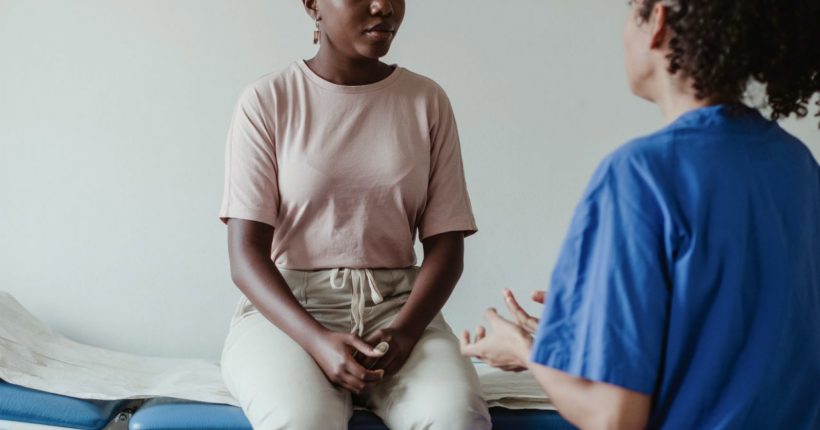Written by Lauren Geall
As Stylist’s digital writer, Lauren Geall writes on topics including mental health, wellbeing and women’s issues. She’s also a big fan of houseplants and likes to dabble in film and TV from time-to-time. You can find her on Twitter at @laurenjanegeall.
According to the eating disorder charity Beat, the average GP has received less than two hours of specialised eating disorder training. Here’s why that’s a problem.
Content note: this article contains details of an eating disorder that some readers may find upsetting.
Deciding to seek help when you’re suffering from an eating disorder can be incredibly difficult; more so, when the professional who’s supposed to help you fails to recognise the extent of the challenge you’re facing. But that’s a reality patients across the UK continue to face.
In response, a number of new campaigns are being launched to provide those on the frontline of the UK’s healthcare system with the training they need to identify and treat eating disorders at the earliest possible stage.
In May, the Royal College of Psychiatrists released new guidelines designed to help health professionals identify eating disorders at any stage, after NHS data found an 84% rise in the number of disordered eating-related hospitalisations in England over the last five years.
And just last week, the eating disorder charity Beat published a new e-learning tool designed to equip GPs and primary care professionals with the tools they need to spot someone who is struggling.
This shift isn’t just incredibly important – it’s desperately needed. Anorexia, in particular, has long been known as one of the deadliest mental health conditions, a reality which stems in part from myths and misunderstandings about what someone who is seriously ill with an eating disorder looks like.
But these devastating outcomes aren’t inevitable: it’s possible for those who are suffering to make a full recovery, especially when the condition is spotted and treated early.
“We need to raise awareness of common eating disorders symptoms,” said Dr Dasha Nicholls, who chaired the development of the Medical Emergencies in Eating Disorders guidelines. “Our guidance encourages healthcare professionals to spot when someone is dangerously ill and dispel the myths surrounding them. They remain poorly understood with devastating consequences for thousands of patients and their families.”

Nicholls continued: “If we are to stop the eating disorders epidemic in its tracks, it’s vital that this guidance reaches healthcare professionals urgently and that government backs them with the necessary resources to implement them.”
Rhiannon, 37, from Warwickshire, is one of the many patients who have struggled to get help from their GP. Rhiannon was eventually diagnosed with anorexia after numerous requests for help, during which she was subjected to horrific treatment from a GP, whose behaviour led her eating disorder to get worse.
Here, she tells her story – and explains why the conversation about the need for professionals to have more training is so important.
“I first started struggling with an eating disorder in the last year of my undergraduate degree. I’d never had any issues with my body – I was pretty happy in myself, actually – but I decided to join the gym to get a bit healthier. The first time I stepped on a treadmill, however, I was drawn to the calorie counter on the screen. At the time, I saw the amount I’d burned as a symbol of the extra food I could eat that evening. This quickly led to cutting down the amount I ate during the day, too, so I could ‘reward’ myself in the evening with more food. It was the start of a dangerous cycle.
“While this pattern went away for a little while after I finished my degree, it came back full force when I moved to a new city to start my PhD. I became more and more isolated because I just wanted to focus on food all the time. I knew I had a problem – and the people around me were concerned – but I didn’t think I was too bad, so told myself I’d seek help in a few years’ time if necessary.
“Then I moved to Birmingham, and things got even worse. My exercise habits became obsessive and I’d shut myself away in the evenings so I could be alone with my food. I even started eating the same thing every night in a really ritualistic way. Over time, the exercise got more and more and the food got less and less. Before I knew it, I found myself in a hole – and I decided to get help.
“When I went to the GP, however, my experience was horrific. By the time I booked an appointment I was definitely too thin – especially for my age and height – but the doctor told me he didn’t “see a problem” because I looked “great”. He also questioned my desire to seek help and gain weight.
“Throughout the appointment he was really focused on my weight, even though visible physical symptoms aren’t the only sign of an eating disorder. For example, I was at a point where I was running for way too long every day, and I knew I didn’t look the same way I did when I was healthy. As a whole, the appointment left me feeling really ashamed – I thought I was wasting his time – and helpless, because even though he told me I shouldn’t worry, I knew something wasn’t right and felt lost about what to do next. The appointment also triggered a lot of disordered eating thoughts because I felt like I wasn’t ‘thin enough’; in turn, I committed to my harmful habits even more.
“After another year of struggling and moving to a different city, I decided to try again. This time, I got a referral to a psychiatric service for an initial meeting, but it didn’t go well. The appointment itself was held inside an eating disorders unit at a local hospital, and seeing all the people there made me feel like a fraud – especially after what I’d been told by the GP I saw initially. After one appointment, I fled – and didn’t end up seeking any more help for another two years.
“Of course, during that time, I got worse and worse. Looking back now, it’s frustrating, because if the GP who saw me in the first place had been properly trained, they could have spotted I was on a downward spiral and prevented me from reaching rock bottom. It’s so ridiculous that you have to get to such a bad place before your requests for help are dealt with or taken seriously.
“There are, of course, some primary care professionals who are really good. On my third attempt to seek help, the GP I saw took one look at me and sent me straight to the local eating disorder service at the hospital and they took me on from there. Since then, I’ve been on a very slow climb upwards – and now I’m happy to say I’m fully recovered.
“While I was definitely grateful to receive help (although I had problems with my secondary care, too), it’s still upsetting to me that it took so long in the end. Any more training that we can give primary care professionals would be so helpful, I think.
“GPs should be able to spot people who need help, even if they don’t come in, like I did, having identified a problem within themselves. For example, if someone goes to them with a repetitive strain injury in their foot because they’ve been exercising every day, that should be picked up on. Those kinds of things could start a conversation and give the healthcare system time to help people before they reach rock bottom.”
In a statement, a spokesperson for NHS Birmingham and Solihull said: “While we cannot comment on individual cases, everyone in Birmingham and Solihull has access to specialist, multi-disciplinary eating disorder services led by Consultant Psychiatrists with expertise in this field, with referrals accepted in line with NICE clinical guidelines from GPs, general adult psychiatric services, community services and child and adolescent mental health services. The conditions covered include suspected diagnoses of anorexia nervosa, bulimia nervosa or other specified feeding and eating disorders.
“Any complaint or concern about an individual GP’s care should be raised locally by the patient in the first instance, so this can be investigated appropriately.”
For information and help on eating disorders, you can visit the eating disorder charity Beat’s website.
Images: Getty
Source: Read Full Article






